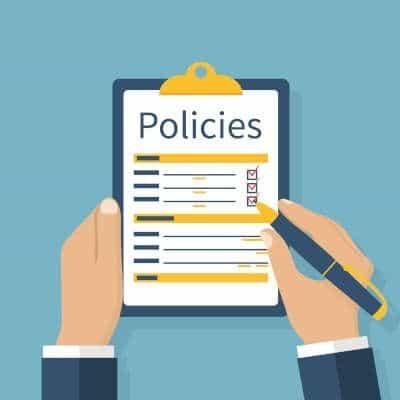There is no greater tool for your business’ success than the technology it uses, at least in theory. If you want to maximize the value you get from your technology, you need to make the correct decisions, which is easier said than done. Let’s go over some of the things to not do with your business technology.
Tip #1 – Get a Workspace Sometimes it is hard to rearrange your life, but it is much easier to rearrange your home. If you are being asked to work from home, or if your kids are going to be telelearning or doing a hybrid approach like many schools are doing these days, a space to do work is crucial. It gets a little hairy when online school and work overlap, but most people’s homes are filled to the brim with leisure space. You’ll need a dedicated workspace if you want to get anything done. Tip #2 – Prepare Like You Always Would Just because you aren’t going to leave the house doesn’t mean you should act like you aren’t. A great way to get yourself in a productive frame of mind is to get up and go through your routine like you would if you were leaving all day. Sure, your cat will still try to sleep on your desk, but getting in the right frame of mind is really important if you want to be your best during the workday. Tip #3 – Limit Your Social Media Use It’s completely understandable that when you are home that you would want to engage with people via social media. The problem is that you are expected to be working or doing schoolwork and social media is a never ending distraction. To facilitate this change, it is a good idea to remove social media shortcuts from your work browser or use a whole other browser for work. You can also choose to use an incognito window for work so that you don’t have as easy of access to your social accounts. Tip #4 – Understand When You are Most Productive Even when you were working from the office or going to school, you didn’t spend all day focused on your work. Most people don’t work like that. The ones that claim to typically sign the checks. You need to know when you are most effective and buckle down during those times. Save your most difficult tasks for times when you are at your best and your workday will get easier. Tip #5 – Make Sure Everyone is On the Same Page In order for you to be productive you need to sustain focus. If there are constant distractions coming from the other people at your house, you likely won’t get much done; and what you get done will likely not be your best. You need to communicate your needs and expectations with the people who are around you. Set ground rules that make everyone understand that when you are at work that you are not to be disturbed. It’s hard to work from home if people keep bothering you all day long. Tip #6 – Communicate with Others While you try to manage your distractions at home, you need to understand that you still have a team out there that works more effectively if you are on the same page, too. Be sure to reach out to your co-workers to talk about work or life every once in a while. You are working from home, not the Sahara Desert (unless that’s where your home is), make sure the people you work with know you’re still alive. Working from home or going […]
A list of your key contacts One of the most important elements in your business continuity plan is a list of all your important contacts who should be informed of the disaster. This can include all your C-level execs, HR managers, IT Manager, client facing managers, etc., A comprehensive list of your IT inventory Your business continuity plan should contain a list of all the softwares, apps and hardware that you use in the daily operations of your business. This list should identify each of those as critical or non-critical and mention details pertaining to each of them such as The name of the app/software Version/model number (for software/hardware) Vendor name and contact information for each of them Warranty/support availability details Contact information for customer support for these hardware/apps Frequency of usage Backup information Data backups are critical to your disaster recovery and so your business continuity plan should include information about data backups. It should mention how often data is backed up, in what formats and where. It should also mention what data backups are available–ideally, you should be backing up ALL data already! What’s your Plan B? Make sure your business continuity plan lists a backup operations plan that will come into play in the event of a disaster. Examples include alternative workflows such as options to work remotely or to allow employees to bring their own devices to work (BYOD) until the time regular business premises or systems are ready. Floor plans and location Your business continuity plan should also include floor plans of your offices with the exit and entry points clearly marked up, so they can be used in the event of any emergency. It should also mention the location of data centers, phones, key IT systems and related hardware. Process definition Make sure your business continuity plan defines the SOPs to be followed in the event of an emergency. Think business continuity planning is too complicated? Don’t give up! A lot of SMBs, don’t create a business continuity plan thinking it is too much of a hassle. But this can prove fatal to your business later. A qualified MSP can help you understand business continuity planning and even help you create a business continuity plan that’s best suited for you..
It helps retain clients As a business, if you have problems functioning, it will definitely affect your clients. For example, if your servers are down or your supply-chain mechanism is affected or your delivery process breaks, you won’t be able to fulfill your promise to your clients. Even worse, in some situations you may not even be in a position to communicate about the crisis to your clients adding to their frustration. A business continuity plan addresses these issues beforehand and can help reduce client dissatisfaction. Salvaging brand image and reputation There are certain events that end up affecting only your business. For example, ransomware attacks, virus attacks, data leaks, etc., Having a business continuity plan that caters for such events can be a blessing in times of such crisis. Minimizing revenue loss A business continuity plan can minimize the revenue losses that occur as a result of a crisis that interrupts your business operations. In short, a business continuity plan helps minimize the impact of the crisis on your client relations, your brand image and your revenue by equipping you with a plan to handle the situation better.
While a business continuity plan cannot completely safeguard your business from all these events, it can certainly minimize the damage inflicted on your business. Top business consultants urge their clients to develop a business continuity plan as they consider it a part of the best practices for running a business. A business continuity plan can make the difference between survival and shutdown of a business during a crisis situation. What is business continuity planning? Business continuity planning is the process of creating a blueprint that helps your business respond and recover effectively from an unforeseen mishap. As discussed before, the unforeseen event could range from natural disasters to pandemics, or even accidents that affect just your place of business like a fire or even a cybercrime attack directed at your business in particular–basically, any event that can paralyze your business. A business continuity plan serves as a step-by-step guide that you can follow during an emergency to keep your business running smoothly. True, a business continuity plan is not a sure shot method to survive a crisis, it won’t instantly eliminate the impact of the disaster, but it gives you the best chances of survival. If you are not sure of what a good business continuity plan entails , you can reach out to a reputable MSP to help you with the preparation and implementation of one.
As of this writing, nearly a quarter of all businesses are still using Windows 7 for one reason or another. Having chosen not to upgrade to Windows 10 (or didn’t want to upgrade their Windows 7-dependent software) when it was offered free, with fears that it would be more mobile device oriented, it seems these businesses don’t want to fork over the money to upgrade away from Windows 7. The problem with this strategy is that, as we mentioned at the outset, Windows 7 is no longer supported by Microsoft and is a major security problem. With no more security patches and updates, the OS will become filled with vulnerabilities, exposing business data. Is your business one of the whopping 47 percent of businesses that were still using Windows 7 when Microsoft retired it in January? Can your business afford to lose control over its data? What Makes Using Windows 7 Bad? Windows 7 was released over a decade ago in July of 2009. In that time, Microsoft has upgraded its OS multiple times. So, while its functionality and usability are decent, it is a ticking time bomb because Microsoft no longer patches or updates the software. It’s not hard to fathom hackers taking advantage of this as they try to steal data and access from the millions of people who still use Windows 7. FBI Says Using Windows 7 is Negligent Law enforcement is even mentioning that it’s a liability to use Windows 7. The Federal Bureau of Investigation released the following statement to their corporate partners in the private sector: “As time passes, Windows 7 becomes more vulnerable to exploitation due to lack of security updates and new vulnerabilities discovered.” Although they especially mention enterprises in the release, it’s not just major corporations that have something to lose by using old and unsupported software. You wouldn’t buy a window that is already cracked, would you? Windows 7 is that cracked window. For companies that utilize legacy software that doesn’t run on Windows 10, it’s probably because there is a better version of that software, too. Besides, if you actually needed to run an old piece of software in order to do your job, there are cloud-based alternatives to run legacy software. There is simply no good reason to run Windows 7 on a machine that is connected to the Internet. What Should My Company Do? Plan your upgrade today. The IT professionals at SRS Networks can find you the hardware, software, and other technology resources to meet your business’ needs. Our technicians are versed in all manners of business technology and specialize in promoting a secure, efficient computing environment that can take your business where you want it to go. For more information about Windows 7, Windows 10, or any other technology question you may have, call us today at (831) 758-3636.
To begin, check the version of Android that you have installed. A few of these tips will require that you’re using Android 10, and some may not work on all devices. Interacting with Your Android Notifications How to Clear Your Notifications Once a notification has, well, notified you of something, its job is done, so it can be dismissed. Doing so is as simple as swiping it to the right or to the left. Dismissing all your notifications at once only requires you to scroll to the bottom of the notification list and select the Clear all option. Silent notifications can be cleared by tapping Close. Some notifications will only dismiss if the process it describes is no longer active. For instance, a notification that informs you that your music player of choice is active will require you to stop the music before the notification will go away. How to Snooze Your Notifications You can also “pause” your notifications by snoozing them. This will require you to activate snoozing in your Settings. Under Apps & notifications, Notifications, and Advanced, you’ll find the option to Allow notification snoozing. Once you’ve done so, you can snooze an individual notification by slightly dragging it to the side and selecting the Snooze option (which is presented as a small clock icon). The Down arrow allows you to select the time that the notification will be postponed. How to Review Your Options Some notifications have multiple options for you to act upon. Expanding these notifications is just a matter of pressing the Down Arrow and making your selection from the options that pop up. Selecting Your Notifications How to Change Your Device’s Notifications In your Settings, select your Apps & notifications and in there, Notifications. You can then select your default notification options from the following options: On lock screen Allow notification dots Default notification sound Swipe fingerprint for notifications Do Not Disturb Activating and Deactivating Notifications for Certain Apps There are multiple options available to you in terms of setting your notifications. In your Settings application: Select Apps & notifications, and from there, Notifications Under Recently sent, you can see all the applications that recently sent you notifications. From there, you can turn off all an app’s notifications, among other capabilities. From the notification itself: Tap and hold your notification, and then tap the gear icon that appears to represent the Settings. You can then select the settings of your choosing, either to Turn off notifications or to select which notifications are Alerting or Silent. In the actual app, you may have the option to change your notifications in the settings as well. Selecting which Notifications Can Interrupt You Some Android devices enable you to select the notifications that an app will provide. Alerting will alert you with a sound, a lock screen message, and a status bar icon. Silent will obviously not provide a sound or vibrate but will still provide a notification if you swipe down on your screen. You have a few options as to how to select these settings. In the Settings application: Tap Apps & notifications, and then Notifications […]
Tip # 1: Cover Everything When putting together your employee handbook, you will want to first prioritize what policies, processes, and procedures you would want every member of your staff to know. Obviously, the more information an employee has, the better he/she will understand what is expected of him/her. Some of the information will need to be in there by law, including: FMLA information Non-discrimination policies Sexual harassment policies Worker’s compensation policies Other policies that are important will also want to be included. They include: Paid-time off policy Payment times and promotion/review policy Employee behavior expectations Employee dress code Benefit structure Remote work policy Social media and employee device policy Finally, you will want to outline your company’s mission, history, and any other company culture-related information that you find important to publish. Tip #2: Prioritize the Layout Obviously, most businesses won’t be able to write every policy and procedure employees should know in a handbook that most employees will simply discard the first day they get one. It is, then, extremely important which policies are written toward the front of the handbook. Along with this, you will need to ensure that each policy is sufficiently explained. You don’t need to be a professional writer, just explain the policies completely and try to be thorough. Tip #3: Update as You Go As important as company policy is, there should always be an opportunity to update it as things change. Having success or failure with any single policy could require amendments be made to them. This means that while giving an employee a handbook when he/she starts working for your company, you should always provide digital access to this document as you will likely need to make changes to it in the future. Ensuring that your handbook is updated with the most current language keeps confusion to a minimum. An employee handbook may not seem crucial, but it can be a beneficial piece to add to your administrative resources. If you would like help putting together your policies, IT or otherwise, call the business experts at SRS Networks today at (831) 758-3636.
The COVID-19 pandemic is the first time many of us have had to deal with this level of threat, and now that businesses start to re-open in an attempt to stagnate a recessionary dive in the economy, there is a lot of ground to cover. Today, we go through the considerations you need to make, and the actions you need to take, to keep your business clear of COVID-19, and what steps to take if the virus makes its way into your business. Mitigation Understand Requirements While stay-at-home orders may be lifted, there are many other regulatory bodies and authorities that will put forth various restrictions for the sake of public health. Whether imposed by federal, state, or local governments, or tailored to a particular industry that has specific requirements for their operations, it is critical that these directives are followed to the letter. In the current situation, this becomes especially important in terms of the standards assigned by the Occupational Health and Safety Administration (OSHA) and the Centers for Disease Control and Protection (CDC). Make sure you take the time to check for additional requirements applicable to your business’ industry, in addition to what applies to all businesses. Compliance to ADA Rules Many workplaces may consider testing for COVID-19 before allowing access to a business’ premises by anyone, which itself will require a few decisions to be made (how these tests are administered, who administers them, and the type of test to be used) and for these results to be protected as medical information. The Americans with Disabilities Act and other assorted state laws also outline that these tests are only permitted if there is doubt that an employee can perform their job without posing a threat to themselves or their coworkers. While this standard was deemed to have been met by the U.S. Equal Employment Opportunity Commission, any updates could potentially change whether or not this screening is allowed. Check with your legal counsel before proceeding with these protocols. Office Cleanliness From your workplace to the employees to work there, you need to do everything you can to encourage a cleaner and healthier environment. Provide a few reminders pertaining to basic hygiene practices around the workplace, and make sure that it is cleaned and disinfected properly. Keeping the HVAC systems well-maintained and the office well ventilated also helps. Social Distancing Adoption Of course, we can’t discuss mitigating COVID-19 without bringing up social distancing. While many businesses are notorious for their close-quarter layouts, shared resources, and even their displays of etiquette, these need to be adjusted to maintain the recommended six feet (or more) of distance between people. Stagger shifts and enable telework, put up barriers and mark off boundaries, and discourage in-person meetings. Safety Protocols and Precautions It will also be necessary for you to put new rules and procedures in place to better ensure that your workplace is contributing as little risk as possible for your employees. This means that you will need to assign someone the responsibility of overseeing that all workplace processes are compliant with safety regulations. You will also need to be prepared to provide as many protections as possible for your employees, handle your staff and their potential absences in accordance with the law, and (as we’ll cover below) properly deal with an […]
Block Sender Of all the things that make managing email difficult, spam has to be at the top of the list. In fact, it can be downright dangerous. Spam can be reduced, but it’s very difficult to eliminate entirely, so it’s important to be diligent. Outlook’s spam filter is very well received, but a couple manual tweaks will improve it even more. The Block Sender option is pretty straightforward. You choose an email sent from an address that you identify as spam, you right-click on the email, choose junk from the dropdown menu, and click Block Sender. This will ensure that you don’t get any more email from that address. Outlook’s Rules Obviously, you want your email to work for you. Fortunately, Outlook’s rules are incredibly flexible, and dynamic. To make Outlook yours, you will want to spend some time and assess how to change these rules to fit your needs. Let’s try a simple change: Say you are working on a project and you want to direct all the emails that come in about that project into a custom folder in Outlook. You can make a rule that completes this function for you. Just select the first email you want to move into a custom folder. Go to Home > Rules > Create Rule at which time you will be prompted with “When I get email with the selected conditions (Subject, From, Sent to) do the following”. After which you will enter the conditions that will set the filter allowing you to see the emails that you want. Outlook is a solid tool that has a lot of features that can help you be more productive. Call SRS Networks today at (831) 758-3636 to talk to one of our IT professionals about working with Microsoft Office 365.










